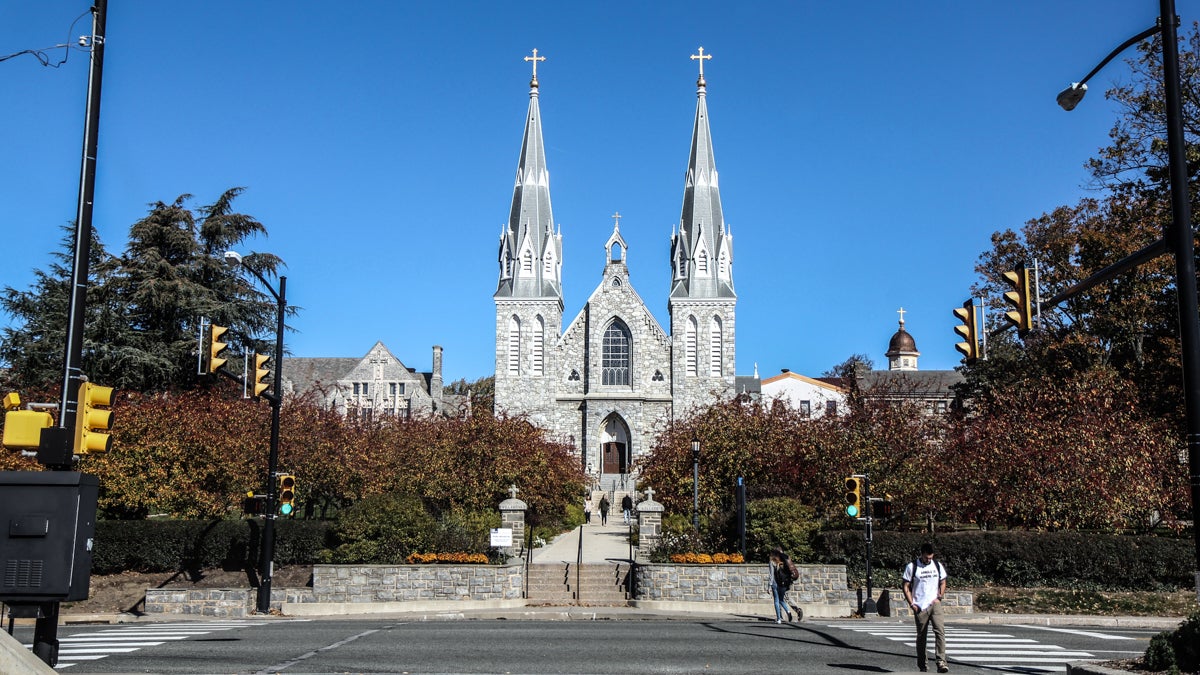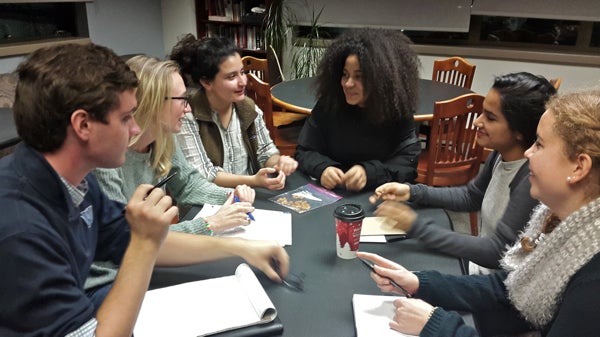For many, Villanova’s push for more inclusive campus moving too slowly
Listen
The number of students of color attending Villanova University is up 10 percent since a decade ago. (Kimberly Paynter/WHYY, file)
On Nov. 12, a black woman walking the Villanova University campus was allegedly attacked by a group of men shouting “Trump.”
The incident was one of many following this year’s presidential election, as students of color from Villanova to the University of Pennsylvania to area high schools bore the brunt of racial slurs and violence.
According to the Association of American Colleges and Universities, a group that promotes liberal humanities education, race-based violence on college campuses often arises during times of large shifts in policy such as desegregation or affirmative action.
At Villanova, a group of students rallying for more diverse course offerings and representations on campus said the school’s culture — in and out of the classroom — is partially to blame for the incident’s racial overtones.
As college campus demographics shift at Villanova and around the country, efforts to change the curriculum at the majority white, Catholic university on the Main Line have gotten mixed reception.
Questioning authenticity of diversity effort
Villanova freshman Victoria Nelson has light brown hair and a spray of freckles. This year, she said one of her professors aired opinions in class he might not have if he had known she was biracial.
“Such as referring to black people as ‘those people,'” she said. “Another comment included … that slavery was necessary in America because somebody needed to do the work.”
Since 2004, the Augustinian Catholic University has crafted and followed an explicit “diversity blueprint,” aimed at recruiting students, staff and faculty of varied backgrounds. In 2016, about 600 — or 10 percent — more students of color are studying at Villanova’s campus in wealthy Radnor Township than a decade ago. The undergraduate student body and faculty remain more than 75 percent and 80 percent white, respectively
In spite of aggressive recruiting efforts and shifting demographics, comments like that of Nelson’s professor — as well as the politically fueled assault — leave some students feeling unwanted.
“My dad’s black, and, because [the professor] didn’t know that identity of me, he felt comfortable saying those comments,” said Nelson. “It was very hurtful to me.”
Nelson filed complaint about the incident. During that process, she said a common retort was that the school should include many points-of-view.
“I heard that, ‘Oh well, we do like to encourage opinions of difference within the classroom,’ and I agree,” she said. “It’s also important to discuss opinions without diminishing someone’s existence. And I think the line is sort of grey.”
Seeking a new perspective
Nelson belongs to an eight-member student group that’s pushing the administration to think differently about its core curriculum — which includes a big dose of Catholic education — to connect with its changing student body.
 Villanova students (From left) Brendan Carchidi, Mary Kathleen “MK” Smith, Gabriela “Gaby” Puche, Madiah Gant, Kinjal Dave, and Victoria Nelson are pushing for a more inclusive curriculum. (Laura Benshoff/WHYY)
Villanova students (From left) Brendan Carchidi, Mary Kathleen “MK” Smith, Gabriela “Gaby” Puche, Madiah Gant, Kinjal Dave, and Victoria Nelson are pushing for a more inclusive curriculum. (Laura Benshoff/WHYY)
“If you’re teaching that Augustine is a man of color from northern Africa, which is something that is glossed over, maybe words like ‘white power’ would not be written in the tunnel,” said sophomore Gabriela Puche during a recent strategy meeting.
That’s the same SEPTA-owned tunnel on campus where the black student was attacked. [The victim chose to halt the investigation and her name has not been released. Right-wing news outlet Breitbart later posted a story questioning the validity of the attack. In the previous three years, Villanova reported no hate crimes on federally mandated campus safety forms.]
While the group has organized protests that can draw students and faculty in large numbers, getting course offerings to reflect — and entice — a more diverse student body has been a slow march that predates this batch of engaged students.
The very first academic program to focus on people of color — called “intergroup relations” — came with a bribe.
“The way that we started it was, the students got no credit and came primarily because I cooked them dinner,” said Terry Nance, associate professor of communications and, more recently, associate vice provost for diversity and inclusion.
As the first full-time black faculty member at Villanova, Nance has turned into a veritable one women diversity crusader, toting a rolling suitcase full of files and class notes to meetings across campus.
“I am that fly on the wall, that when there’s a curriculum meeting, I’m saying you know … we haven’t looked at climate in a while,” she said.
Intergroup relations is now an accredited course, and the College of Liberal Arts and Sciences, which enrolls about half of Villanova undergrads, requires students to take two classes of their choosing with a diversity component.
“They’re not classes that are just like ‘just add women and stir’ or ‘just add African-Americans and check,’ it’s diversity,” said dean Adele Lindenmeyr. “We do make sure the courses talk about power and influence and context.”
Some private reservations
But mandating classes on racial, ethnic or religious differences has gotten pushback from some students and faculty.
“That’s incredibly dangerous, if you start forcing more requirement on people, who wouldn’t voluntarily be taking the courses,” said Derek Fake, vice president of the Villanova College Republicans.
By “dangerous,” he said he means alienating to students whose views are challenged, with the potential to widen rifts between students.
Fake said he appreciates the focus on European philosophers and Christian values covered in the four required liberal arts and sciences courses.
“I think what’s really lacking in our society isn’t diverse opinions. That’s something that can easily be thought about after, if you want to. But we don’t authentically understand where we come from as a culture,” said Fake.
Dozens of faculty members have aligned themselves with student activists pushing for more transparency and inclusivity. Last year, they protested together after the school announced it would transition from a campus security force to an armed police force.
Privately, some have expressed dissent about changes aimed at their classrooms.
“There is some grumbling from faculty,” said Mark Doorley, director of the ethics program in the College of Liberal Arts and Sciences. “About needing to jump through hoops, wondering how many students are we talking about, wondering if we are going to do X, Y, Z thing for a minority of students and most of the students aren’t interested in this.”
For several years, Doorley has been involved with an initiative to recruit Latino students to the school, many from New York City. Trough that program, he has seen the adjustment period get shorter and and easier.
“It’s a very different experience for them now,” said Doorley.
While Doorley and Lindenmeyr describe a commitment by most faculty, the College of Liberal Arts and Sciences is staying away from more mandates going forward, according to Lindenmeyr. Instead, each department has a diversity committee, assigned to chart a path to inclusion in their own curriculum.
Challenging ‘Villanova nice’
In conversations with students and faculty, the concept of “Villanova nice” kept coming up.
“Villanova is — I don’t want is say apolitical but — apathetic. We’re all really nice and don’t want to step on anybody’s toes,” said sophomore Puche.
That extends to the classroom as well.
“There are Trump supporters here who won’t talk out loud because they don’t want to get attacked,” said Doorley, who said his offer to have a classroom discussion about the recent election results was met with crickets.
“You can read it as politeness or you can read it as civility here,” said Lindenmeyr. “We don’t want people to get into shouting matches.”
Protesting goes against that culture — but stepping on toes gets attention. Puche and her cohort say even before the election, the administration seemed more receptive to student protests and demands than in years past. They now meet with deans and administrators, shopping around an ever-growing list of demands that ranges from more minority representation in campus murals to training faculty about implicit bias.
“I’m not upset at all that they’re dissatisfied with us because that’s the only way that it’s going to get better,” said Nance.
Next up, students have a big target in their sights — getting Villanova’s well-ranked business school to make a point of teaching diversity as a basic principle and not an optional add-on.
“The marketplace is looking for people with cultural competency,” said senior Kinjal Dave, ready to pitch their case.
WHYY is your source for fact-based, in-depth journalism and information. As a nonprofit organization, we rely on financial support from readers like you. Please give today.

